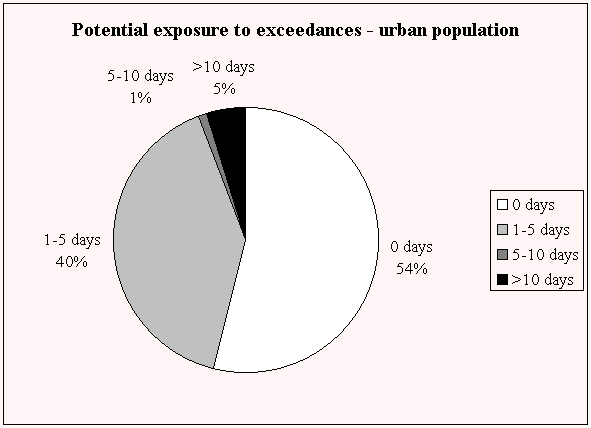5
POPULATION EXPOSURE TO EXCEEDANCES
The actual outdoor exposure of the
population to ozone is difficult to estimate. In addition to
estimating the spatial distribution and time variation of the
ozone concentration, the location and physical activity level of
the population should be known. Since detailed data about these
variables is not available, the description of exposure must be
limited to estimating the number of people which possibly
experienced ('were potentially exposed to') at least one
exceedance of ozone concentrations above the information
threshold value during summer 1996.
For rural areas, the number of people
exposed to at least one exceedance could not be calculated. The
interpolated exceedance 'field' (Map 3) is too fragmented.
Moreover, no rural population database is available at the
moment.
For urban areas, using a Geographical
Information System, the location of urban stations was combined
with an urban population database provided by Eurostat [6]. This
database lists ca. 2100 cities in the EU with more than 25 000
inhabitants. It is estimated that from a total EU population of
ca. 362 million, ca. 195 million people live in these cities.
Approximately 66 million people live in cities in which at least
one ozone station was operational during the 1996 summer season
(34% of the total EU urban population or 18% of the total EU
population). 142 cities reported at least one exceedance of the
population information threshold value. Approximately 31 million
people in these cities (46% of the urban population living in
cities with operational monitors) were potentially exposed to at
least one exceedance. The urban exposure estimates are presented
in Figure 8.
The results should be interpreted with
great care. In many cities, only one station is operational and
exceedances at such a station were attributed to the whole urban
population. The current description of station types is unprecise
and for a substential number completely missing. Nevertheless, it
is obvious that urban population exposure estimates cannot be
based on monitoring results alone, since monitoring stations
cover only 34% of the total urban population.

Figure 8: Number of exceedances (in days) and frequency
distribution of urban population potentially exposed to hourly
ozone concentrations exceeding 180 µg/m3, April-July 1996.
(Representative for a urban population of 66 million (34% of the
EU urban population) living in cities with more than 25 000
inhabitants; 18% of the total EU population).


Document Actions
Share with others